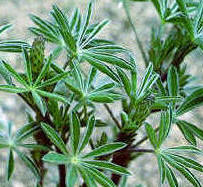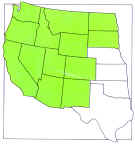| Lupine (Lupinus spp.) |

|
Not all lupines are poisonous, nor do all species cause birth defects. Six of the poisonous species implicated in "crooked calf disease" are silky lupine (L. sericeus), tailcup lupine (L. caudatus), velvet lupine (L. leucophyllus), silvery lupine (L. argenteus), lunara lupine (L. formosus), and yellow lupine (L. sulphureus). Poisonous species of lupine are dangerous from the time they start growth in the spring until seed pods shatter in late summer or fall. Younger plants are more toxic than older plants; however, plants in the seed stage in late summer are especially dangerous because of the high alkaloid content of the seeds and enhanced palatability in preference to dried senescent grasses. Under certain conditions and in many countries, sweet lupines are used as animal forage and seeds for human consumption. Where and When It Grows Lupine is found on open and wooded hillsides. Poisonous species grow from 0.3 to 1 meter tall. Leaves are composed of several leaflets, which radiate from a central point. Although blue is the most common color, flowers may also be white, pink, yellow, or blue and white. Silky lupine grows in northern areas from Washington and Oregon east to South Dakota. Tailcup lupine is found in Oregon, California, Idaho, Utah, Montana, and Wyoming. Velvet lupine is found in an intermountain region from Oregon to Wyoming. Silvery lupine occurs from North Dakota and Idaho south to Arizona and New Mexico. Lunara lupine grows in California. Yellow lupine is found in the northwestern states. How It Affects Livestock Cattle may be poisoned by eating 0.5 to 1.0 kg of lupine. Smaller amounts are poisonous if cattle eat lupine daily for 3 to 7 days. Crooked legs and other congenital deformities occur in newborn calves if cows graze certain species of lupine (L. sericeus, L. caudatus, L. laxiflorus, and L. sulphureus) between the 40th and 70th gestational days. Signs and Lesions of Poisoning How to Reduce Losses If cows in the susceptible gestational period (40th to 70th days of gestation) are kept from lupine when it is most teratogenic (very early growth or seed pod stage), most deformities can be prevented. The congenital deformity hazard is minimal at other gestation periods and when plant is in early flower stage or after pods have shattered and seeds have dropped. There is no known treatment for lupine poisoning. Affected animals should not be moved until signs of poisoning have disappeared. Lupine can be controlled with 2,4-D (1 kg ae/Ac), 2,4-D + dicamba (0.5 + 0.25 kg ai/Ac), or trichlopyr (0.25 to 0.75 kg ae/Ac). Spray actively growing plants after they are 10 cm high but before they bloom. Reinvasion is rapid and retreatment may be necessary every 4 to 5 years. Follow precautions when handling herbicides. |

 In the Western States livestock, especially sheep, are frequently poisoned by eating lupine seeds and pods. Losses may be especially heavy when hungry sheep are trailed through lupine ranges in late summer. Lupine hay remains toxic and has been reported to poison sheep. More common than direct toxicity, some lupine alkaloids produce birth defects in cattle if eaten during certain gestational times. Cows eating lupine during early gestation often give birth to calves with cleft palates, crooked legs and distorted/malformed spines. Such deformed calves generally have to be euthanized. Epidemic outbreaks of such birth defects can have high morbidity resulting in enormous animal and economic losses.
In the Western States livestock, especially sheep, are frequently poisoned by eating lupine seeds and pods. Losses may be especially heavy when hungry sheep are trailed through lupine ranges in late summer. Lupine hay remains toxic and has been reported to poison sheep. More common than direct toxicity, some lupine alkaloids produce birth defects in cattle if eaten during certain gestational times. Cows eating lupine during early gestation often give birth to calves with cleft palates, crooked legs and distorted/malformed spines. Such deformed calves generally have to be euthanized. Epidemic outbreaks of such birth defects can have high morbidity resulting in enormous animal and economic losses. 